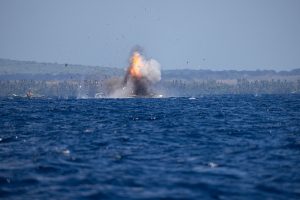On April 22, the 39th annual Exercise Balikatan, the “shoulder to shoulder” joint military drills between the U.S. military and the Armed Forces of the Philippines (AFP), began. This year’s Balikatan exercises are scheduled to run until May 10, and are planned to be the largest joint exercise between the United States and the Philippines thus far.
This year’s Balikatan is happening amid heightened tensions in the South China Sea, with the latest attack on a Filipino vessel happening less than a month before the joint exercises started. On April 30, as the drills were ongoing, Chinese vessels again fired water cannons at two Philippine patrol vessels, this time near Scarborough Shoal.
Even though Balikatan is almost a 40-year tradition, this year’s exercises are larger and more pronounced than past iterations, likely as a response to China’s aggressive behavior in the South China Sea. This year’s exercises will include a multilateral exercise with the U.S., Philippines, and French navy and will take place outside of the 12 nautical miles that mark the Philippines’ territorial waters but remain inside of the Philippines’ exclusive economic zone (EEZ).
This exercise in particular is likely to draw criticism from China, not only because France will be participating in Balikatan for the first time, but also because China’s nine-dash line encroaches into the Philippines’ EEZ. Even if the trilateral exercise avoids the contested waters, the U.S. is on record as supporting the 2016 U.N. Permanent Court of Arbitration ruling that the area within the nine-dash line does not belong to China.
The exercises will host 14 states as observers: Brunei, Canada, France, Germany, Great Britain, India, Indonesia, Japan, Malaysia, New Zealand, South Korea, Singapore, Thailand, and Vietnam. While officials from the U.S. and the Philippines neglected to name China as an aggressor at the Exercise Balikatan 39 Opening Ceremony, vice chairman of China’s Central Military Commission, Zhang Youxia, warned, “Reality has shown that those who make deliberate provocations, stoke tensions, or support one side against another for selfish gains will ultimately only hurt themselves.”
In the months leading up to Balikatan 2024, there have been numerous instances of Chinese and Filipino vessels getting involved in altercations with one another. The Philippines accused the China Coast Guard of “harassing” civilian fishing vessels, and Chinese and Philippines ships have collided on multiple occasions. On March 23, less than a month before the Balikatan exercises kicked off, a China Coast Guard vessel fired water cannons at a civilian Filipino ship near the Second Thomas Shoal, part of the territory encompassed by China’s nine dash line.
These events are examples of China’s gray zone tactics, methods of coercion that do not meet the threshold of an act of war. By relying on gray zone tactics to intimidate vessels in contested waters, China is asserting dominance in contested territory and testing the limits of international law.
The Biden administration responded to the March 23 event by reaffirming the U.S. commitment to the 1951 US-Philippines Mutual Defense Treaty (MDT), clarifying the MDT extends to “armed attacks on Philippine armed forces, public vessels, or aircraft — to include those of its Coast Guard — in the Pacific, including anywhere in the South China Sea.” The clarifying statement is a part of a larger evolution in Philippine-U.S. relations. In April 2023, the United States and the Philippines announced that Manila was giving the U.S. military access to four bases in the Philippines, bringing the total to nine Filipino bases the U.S. military can operate on. Three of the bases are of unique strategic importance, with two bases adjacent to Taiwan and one base looking toward the disputed Spratly Islands.
While the Biden administration’s stated “ironclad” support for the MDT is a clear way of supporting a U.S. ally, the stance may also increase the risk of heightened tensions in the South China Sea. If China wanted to test how strong U.S. commitment to the Philippines is, the Biden administration’s statement removes ambiguity from the equation and highlights a proverbial line that could be crossed. In the unlikely event China targets a Filipino military vessel on purpose, the U.S. would be pushed to uphold its end of the MDT or carve out an exception to prevent further escalation in the area.
A second risk is centered around accidental miscalculation on the part of the China Coast Guard. If the trilateral exercise between the U.S., Philippines, and France happens in or near contested waters, China may be incentivized to respond with their own military exercises in close proximity or continue with gray zone-based aggression toward Filipino civilian vessels after the Balikatan concludes. The more often Chinese and Filipino ships face off in the South China Sea, the more likely a mistake or miscalculation is to take place. For example, China accidentally targeting a Filipino naval vessel instead of a civilian vessel could lead to the MDT being invoked.
Given the growing number of bases the U.S. military can access and the current Balikatan exercises, China is undoubtedly feeling pressure from the evolving U.S.-Filipino partnership. Since China is a regional power, it is likely to feel compelled to respond to any perceived aggression that takes place during the Balikatan exercises. The U.S. and the Philippines are using Balikatan to demonstrate their commitment to their alliance, attempt to deter further aggression in the South China Sea, and to gauge China’s reaction to the evolving partnership. Although the stakes seem high for all three nations, it is in the best interest of every party that tensions decrease in the coming weeks.
To prevent an overreaction from China regarding the multilateral exercise in the Philippines’ EEZ, the U.S. and the Philippines should prioritize transparent communication with China to reiterate the exercise is not a direct threat to China’s security. In the long term, the U.S. should weigh the risks and rewards of having access to additional bases in the Philippines, as antagonizing China may be in no one’s best interest.

































